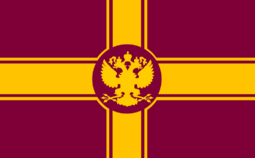Flag of Aciria
The Flag of Aciria (Acirian: Bandiera di Aciria), also known as the Croce d'Oro ("Golden Cross") dates to the 18th century when the Grand Empire of Aciria was formed. The purple background represents the imperial heritage of the nation while the gold represents the wealth and prosperity of the nation. The two-headed eagle in the center represents the state looking both inwards and outwards.
 | |
| Use | National flag and ensign |
|---|---|
| Proportion | 3:5 |
| Adopted | 8 October 1783 |
| Design | A golden cross with a two-headed eagle in the center on a purple background. |
| Designed by | Fabranco Piracci |
The colour scheme and two-headed eagle are shared by practically every area of government, most notably the Imperial Armed Forces of Aciria widely uses the symbols in its crests, accented by red that represents the blood of those who've died for the nation. The cross central to the flag, often referred to as the Occidental cross and widely used by the former territories owned by Caphiria, is sometimes referred to as the Cross of Saint Beatrice in Aciria.
History
The first flag of Aciria was the flag of the Free Republic, created by the First Speaker Silvano de Albairate, where the blue represents the sea of the Marinai people, green the vast fields of Acirians and white the snow-capped mountains of the Montanaros. The balanced scale in the middle represents equality between the peoples.
The use of the flag of the Free Republic was criminalised following the rise of the Empire, with the three months between the criminalization of the flag and creation of the current flag having the state formally lack a flag. The Emperor held a contest for the creation of the new flag of the Empire, with the winner being made nobility and landed, offering any social class a chance to rise in society. Eventually a Trossera vendecolori (literally, colorman), a dyemaker named Fabranco Piracci created the new flag by attempting to make a flag that symbolizes power and wealth. The First Emperor fell in love with the flag instantly, making Piracci nobility and gave him the land he was promised.
Legal definition
Usage
Only the state and those with permission from the state are allowed to fly the Imperial Flag, which is a variant of the flag with specific instruction of material, height and width. The average citizen is permitted to fly an Everyman's Flag where the restrictions are looser, allowing for flag to be hung from balconies, on walls or made as handheld flags.
National holidays see the Imperial Flag hoisted up at exactly 7 AM, with it being taken down at 7 AM the next day, representing the 7 July the Empire was founded. It's illegal to remove the Imperial Flag during these hours, and anyone caught doing so will face either fines or a prison sentence. Prior to 1952, caning was a common punishment for those who'd have removed the Imperial Flag. The flag is also hoisted by schools during graduation ceremonies.
Colours
| Purple | Gold | Red | |
|---|---|---|---|
| RGB | 127/0/55 |
255/195/0 |
186/14/9
|
| Hexadecimal | #7F0037 |
#FFC300 |
#BA0E09
|
| CMYK | 0.00/1.00/0.57/0.50 |
0.00/0.24/1.00/0.00 |
0.00/0.92/0.95/0.27
|
This article is considered abandoned lore either because its creator has changed projects or has left the community. Accordingly, it is not only non-canon but it is also eligible for salvage pending approval from an administrator.
|